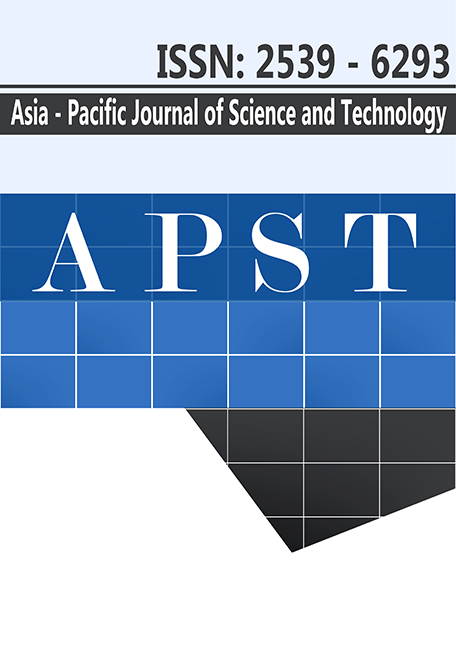Pollen morphology of subfamily Nelsonioideae (Acanthaceae) in Thailand
Main Article Content
Abstract
The pollen morphology of Thai Acanthaceae Subfamily Nelsonioideae was investigated. The pollen type was tricolpate. Their apertures were longitudinal narrow colpi with acute ends. The polar axis length (P) was 16.3-42.5 μm and equatorial axis length (E) was 17.5-37.5 μm. The largest size was represented in Staurogyne dispar, while the smallest showed in Nelsonia canescens, Staurogyne glauca, and S. parvicaulis. The shape varied from suboblate to prolate. Micro-foveolate, foveolate, and rugulate tecta were found in 6, 11, and 7 taxa of Nelsonia and Staurogyne, respectively. Psilate was only revealed in Staurogyne macrobotrya. The wall thickness varied from 1.25-2.5 μm depending on species.
Article Details
References
(1) Bremekamp CEB. Delimitation and subdivision of the Acanthaceae. Bulletin of the Botanical Survey of India 1965; 7: 21-30.
(2) Daniel TF, McDade LA. "Nelsonioideae (Lamiales: Acanthaceae): Revision of Genera and Catalog of Species," Aliso: A Journal of Systematic and Evolutionary Botany. 2014; 32(1). Available at: http://scholarship.claremont.edu/aliso/vol32/iss1/2
(3) Erdtman G. Pollen morphology and plant taxonomy. Hafner. New York; 1966.
(4) Hansen B. Studies on the Acanthaceae of Thailand. Flora Malesiana Bulletin 1985; 9/2: 173-178.
(5) Hansen B. Notes on SE Asian Acanthaceae 2. Nordic Journal of Botany 1995; 15: 583-590.
(6) Heywood VH, Brummitt RK, Culham A, Seberg O. Flowering plant families of the world. Firefly Books. Ontario, Canada; 2007.
(7) Imlay JB. The taxonomy of the Siamese Acanthaceae [PhD Thesis]. Aberdeen, United Kingdom: Aberdeen University; 1938.
(8) Lindau G. Beiträge zur Systematik der Acanthaceen. In: Engler A. Botanische Jahrbücher für Systematik, Pflanzengeschichte und Pflanzengeographie 1893; 18: 36-64.
(9) Lindau G. Acanthaceae. In Engler A, Prantl K. Die Natürlichen Pflanzenfamilien 1895; 4: 274-353.
(10) Radlkofer LAT. Ueber den systematischen Werth der Pollen-beschaffenheit bei den Acanthaceen. Sitzungsberichte Mathematisch-Physikalischen Classe (Klass) der Kӧnigl. Bayer. Akademie der Wissenschaften zu München 1883; 13: 256-314.
(11) Raj B. Further contribution to the pollen morphology of the Acanthaceae. Journal of Palynology 1973; 4: 91-141.
(12) Scotland RW, Vollesen K. Classification of Acanthaceae. Kew Bulletin 2000; 55: 513-589.
(13) Tsui H-P, Hu C-C. Pollen morphology of six species in Thunbergia, of one species each in Staurogyne and Acanthus (Acanthaceae) from China. Acta Phytotaxonomica Sinica 2005; 43: 116-122.
(14) Wheeler JR, Rye BL, Koch BL, Wilson AJG. Flora of the Kimberley region. Western Australian Herbarium. Como, W.A.; 1992.
(15) Wichelen J, Camelbeke K, Chaerle P, Goetghebeur P, Huysmans S. Comparison of different treatments for LM and SEM studies and systematic value of pollen grains in Cyperaceae. Grana 1999; 38: 50-58.

